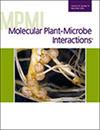求助PDF
{"title":"剑兰伯克霍尔德菌在洋葱叶和鳞茎组织中的不同毒力机制。","authors":"Sujan Paudel, Yaritza Franco, Mei Zhao, Bhabesh Dutta, Brian H Kvitko","doi":"10.1094/MPMI-10-24-0129-R","DOIUrl":null,"url":null,"abstract":"<p><p>Slippery skin of onion caused by <i>Burkholderia gladioli</i> pv. <i>alliicola</i> (Bga) is a common bacterial disease reported from onion-growing regions around the world. Despite the increasing attention in recent years, our understanding of the virulence mechanisms of this pathogen remains limited. In this study, we characterized the predicted genetic determinants of virulence in Bga strain 20GA0385 using a reverse genetics approach. Using the closely related rice pathogen <i>B. glumae</i> as a reference, comparative genomics analysis was performed to identify Bga candidate virulence factors and regulators. Marked and unmarked deletion mutants were generated using allelic exchange, and the mutants were functionally validated using in vitro and in vivo assays. The role of mutants in pathogenic phenotypes was analyzed using onion foliar/seedling necrosis assays, the red scale necrosis assay, and in planta bacterial population counts. The phytotoxin toxoflavin was a major contributor to foliar necrosis and bacterial populations, whereas the type II and type III secretion systems (T2SS/T3SS) were dispensable for foliar symptoms. In onion scale tissue, the T2SS single mutant <i>gspC</i> and its double and triple mutant derivatives all contributed to scale lesion area. Neither the lipocyclopeptide icosalide, toxoflavin, nor T3SS was required for scale symptoms. Our results suggest that the quorum sensing <i>tofIMR</i> system in Bga regulates toxoflavin, T2SS, and T3SS, contributing to onion symptom production. We show that different virulence factors contribute to onion tissue-specific virulence patterns in Bga and that decreases in scale symptoms often do not result in decreased Bga populations in onion tissue. [Formula: see text] Copyright © 2025 The Author(s). This is an open access article distributed under the CC BY-NC-ND 4.0 International license.</p>","PeriodicalId":19009,"journal":{"name":"Molecular Plant-microbe Interactions","volume":" ","pages":"427-439"},"PeriodicalIF":3.4000,"publicationDate":"2025-05-01","publicationTypes":"Journal Article","fieldsOfStudy":null,"isOpenAccess":false,"openAccessPdf":"","citationCount":"0","resultStr":"{\"title\":\"Distinct Virulence Mechanisms of <i>Burkholderia gladioli</i> in Onion Foliar and Bulb Scale Tissues.\",\"authors\":\"Sujan Paudel, Yaritza Franco, Mei Zhao, Bhabesh Dutta, Brian H Kvitko\",\"doi\":\"10.1094/MPMI-10-24-0129-R\",\"DOIUrl\":null,\"url\":null,\"abstract\":\"<p><p>Slippery skin of onion caused by <i>Burkholderia gladioli</i> pv. <i>alliicola</i> (Bga) is a common bacterial disease reported from onion-growing regions around the world. Despite the increasing attention in recent years, our understanding of the virulence mechanisms of this pathogen remains limited. In this study, we characterized the predicted genetic determinants of virulence in Bga strain 20GA0385 using a reverse genetics approach. Using the closely related rice pathogen <i>B. glumae</i> as a reference, comparative genomics analysis was performed to identify Bga candidate virulence factors and regulators. Marked and unmarked deletion mutants were generated using allelic exchange, and the mutants were functionally validated using in vitro and in vivo assays. The role of mutants in pathogenic phenotypes was analyzed using onion foliar/seedling necrosis assays, the red scale necrosis assay, and in planta bacterial population counts. The phytotoxin toxoflavin was a major contributor to foliar necrosis and bacterial populations, whereas the type II and type III secretion systems (T2SS/T3SS) were dispensable for foliar symptoms. In onion scale tissue, the T2SS single mutant <i>gspC</i> and its double and triple mutant derivatives all contributed to scale lesion area. Neither the lipocyclopeptide icosalide, toxoflavin, nor T3SS was required for scale symptoms. Our results suggest that the quorum sensing <i>tofIMR</i> system in Bga regulates toxoflavin, T2SS, and T3SS, contributing to onion symptom production. We show that different virulence factors contribute to onion tissue-specific virulence patterns in Bga and that decreases in scale symptoms often do not result in decreased Bga populations in onion tissue. [Formula: see text] Copyright © 2025 The Author(s). This is an open access article distributed under the CC BY-NC-ND 4.0 International license.</p>\",\"PeriodicalId\":19009,\"journal\":{\"name\":\"Molecular Plant-microbe Interactions\",\"volume\":\" \",\"pages\":\"427-439\"},\"PeriodicalIF\":3.4000,\"publicationDate\":\"2025-05-01\",\"publicationTypes\":\"Journal Article\",\"fieldsOfStudy\":null,\"isOpenAccess\":false,\"openAccessPdf\":\"\",\"citationCount\":\"0\",\"resultStr\":null,\"platform\":\"Semanticscholar\",\"paperid\":null,\"PeriodicalName\":\"Molecular Plant-microbe Interactions\",\"FirstCategoryId\":\"99\",\"ListUrlMain\":\"https://doi.org/10.1094/MPMI-10-24-0129-R\",\"RegionNum\":3,\"RegionCategory\":\"生物学\",\"ArticlePicture\":[],\"TitleCN\":null,\"AbstractTextCN\":null,\"PMCID\":null,\"EPubDate\":\"2025/5/15 0:00:00\",\"PubModel\":\"Epub\",\"JCR\":\"Q2\",\"JCRName\":\"BIOCHEMISTRY & MOLECULAR BIOLOGY\",\"Score\":null,\"Total\":0}","platform":"Semanticscholar","paperid":null,"PeriodicalName":"Molecular Plant-microbe Interactions","FirstCategoryId":"99","ListUrlMain":"https://doi.org/10.1094/MPMI-10-24-0129-R","RegionNum":3,"RegionCategory":"生物学","ArticlePicture":[],"TitleCN":null,"AbstractTextCN":null,"PMCID":null,"EPubDate":"2025/5/15 0:00:00","PubModel":"Epub","JCR":"Q2","JCRName":"BIOCHEMISTRY & MOLECULAR BIOLOGY","Score":null,"Total":0}
引用次数: 0
引用
批量引用

 求助内容:
求助内容: 应助结果提醒方式:
应助结果提醒方式:


